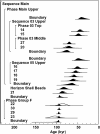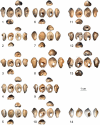82,000-year-old shell beads from North Africa and implications for the origins of modern human behavior
- PMID: 17548808
- PMCID: PMC1891266
- DOI: 10.1073/pnas.0703877104
82,000-year-old shell beads from North Africa and implications for the origins of modern human behavior
Abstract
The first appearance of explicitly symbolic objects in the archaeological record marks a fundamental stage in the emergence of modern social behavior in Homo. Ornaments such as shell beads represent some of the earliest objects of this kind. We report on examples of perforated Nassarius gibbosulus shell beads from Grotte des Pigeons (Taforalt, Morocco), North Africa. These marine shells come from archaeological levels dated by luminescence and uranium-series techniques to approximately 82,000 years ago. They confirm evidence of similar ornaments from other less well dated sites in North Africa and adjacent areas of southwest Asia. The shells are of the same genus as shell beads from slightly younger levels at Blombos Cave in South Africa. Wear patterns on the shells imply that some of them were suspended, and, as at Blombos, they were covered in red ochre. These findings imply an early distribution of bead-making in Africa and southwest Asia at least 40 millennia before the appearance of similar cultural manifestations in Europe.
Conflict of interest statement
The authors declare no conflict of interest.
Figures





References
-
- d'Errico F, Henshilwood C, Vanhaeren M, van Niekerk K. J Hum Evol. 2005;48:3–24. - PubMed
-
- White TD, Asfaw B, DeGusta D, Gilbert H, Richards GD, Suwa G, Clark Howell F. Nature. 2003;423:742–747. - PubMed
-
- McDougall I, Brown FH, Fleagle JG. Nature. 2005;433:733–736. - PubMed
-
- McBrearty S, Brooks AS. J Hum Evol. 2000;39:453–563. - PubMed
Publication types
MeSH terms
Substances
LinkOut - more resources
Full Text Sources

